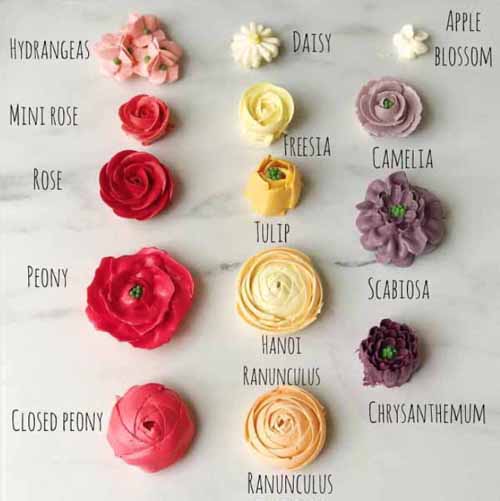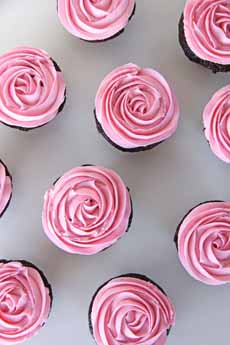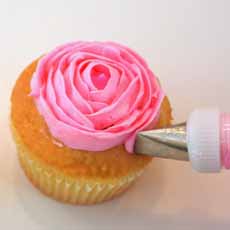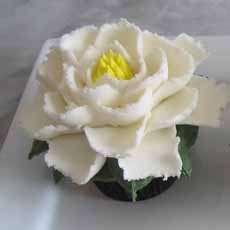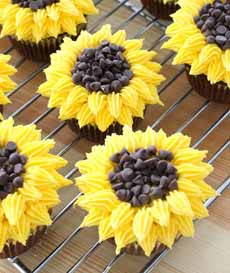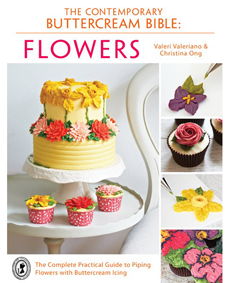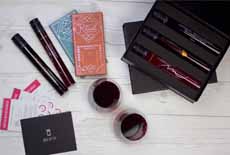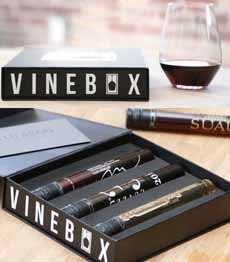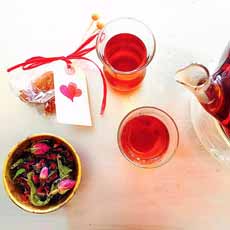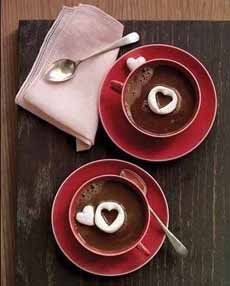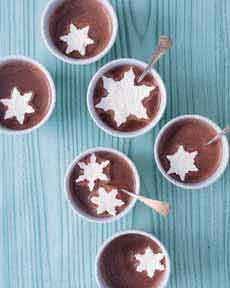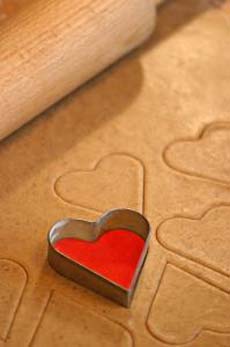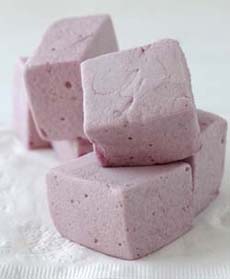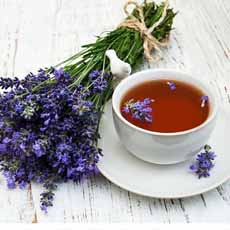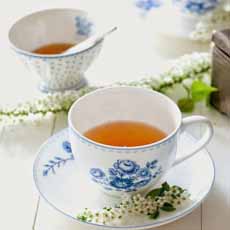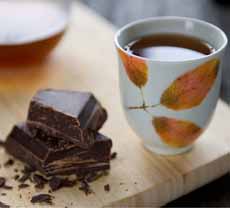
[1] Simple: a bite of chocolate, a sip of tea (photo © Republic Of Tea).
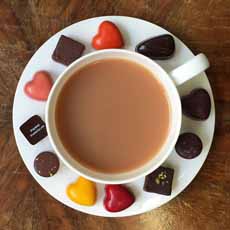
[2] Fancier (photo © Marcolini Chocolate).

[3] Elegant presentation from Republic Of Tea, and…

[4] …Woodhouse Chocolate.
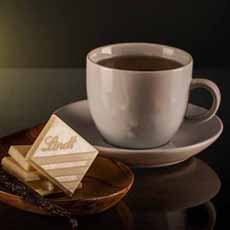
[5] White chocolate pairs with black, green, and herbal teas (photo © Lindt).
|
|
If you’re a tea lover, here’s an idea for just the two of you, or for a larger party of friends: Pair chocolate with tea.
Tea and chocolate are excellent pairing companions. There is so much variety of flavor in each, it seems that there are endless possibilities.
If you have an educated chocolate palate, go further in your exploration. As you would with wine pairings, see what works with what.
We’ve provided some guidelines, but before you start, the rules are:
You need quality tea and quality chocolate.
Remember that as with wine, tea is adaptable to unconventional pairings. The fun (and learning experience) of a tasting party is that you get to try them all, and see which you personally prefer.
There are obvious pairings—citrussy tea with citrussy chocolate, for example; and opposite pairings. Otherwise stated: enhance or contrast.
In other words, there is no right or wrong: just what you like.
Try the teas black, before adding milk (as desired) and sugar (only if you deem it essential).
You don’t have to taste everything in one day. For example, we had an event only with white chocolate pairings.
TEA WITH DARK CHOCOLATE
Dark chocolate also calls for a hearty black tea. The aforementioned Assam, English Breakfast, and Masala Chai work here.
But for adventure, try:
Green tea: Try a nuttier green, such as Dragon Well or Gen Mai Cha.
Lapsang Souchong, Russian Caravan: heavily smoky teas work well with bittersweet chocolates.
Pu-erh‡.
Hojicha: If the chocolate has “red fruit” notes. Single-origin bars from Cuyagua, Ocumare, Rio Caribe, São Tomé, Sur del Lago.
Jasmine-scented Pouchong or lightly-oxidized Oolong. These have floral that pair with single-origin chocolate that has natural floral notes, such as Valrhona Guanaja.
Here’s more information on single origin chocolate flavors.
TEA WITH MILK CHOCOLATE
Milk chocolate should be paired with a hearty black tea that takes milk.
Assam, from the highlands of India has malty characteristics, is ideal (and is one of our favorite teas). As an alternative, English Breakfast is a blend that has a base of Assam*.
Masala chai is Assam with spices. Each home or manufacturer has a favorite mix, which can include allspice, black peppercorns, cardamom, cinnamon, clove, fennel seeds, ginger, nutmeg, and star anise. Here’s how to make masala chai with spices from your kitchen.
Darjeeling* is lighter, but an interesting contrast to the stronger black teas. With a floral aroma. The flavor can include a tinge of astringent tannic characteristics and a musky spiciness sometimes described as “muscatel.”
Earl Grey with milk pairs well with creamy milk chocolate.
Houjicha green tea, Wu Yi Oolong tea, or other “toasty” teas with sweet milk chocolate.
TEA WITH WHITE CHOCOLATE
White chocolate is milky, often with caramel notes. These teas both compare and contrast:
Assam or Earl Grey black tea.
Gen Mai Cha (genmaicha): green tea with toasted rice (also the perfect pairing for a bar with crisped rice [like an artisan Nestlé’s Crunch]).
Herbal teas: rooibos, peppermint and numerous others. This is a pairing where you can find familiar flavors, from anise to lavender.
Jasmine black or green tea.
Masala Chai.
Matcha, Dragon Well or Sencha green teas.
Oolong semi-oxidized† tea.
|
WITH FILLED & FLAVORED CHOCOLATES OR SINGLE-ORIGIN CHOCOLATE BARS
Bonbons and chocolate bars and bark can be flavored with particular seasonings, but single-origin chocolate bars carry the flavors of their particular origins.
When we say a chocolate bar has, say, a profile of “red fruits,” it doesn’t mean that raspberries have been added to it. Rather, the beans are produced in that particular area. Here’s more about single origin chocolate flavors.
But whether the red fruits—or citrus, or coffee, or other flavors—is inherent to the bean or an added flavor, the pairing strategy is the same.
Any fruit-filled chocolate or fruity bar: Earl Grey, Jasmine black or green, floral Oolongs like Ti Kuan Yin Oolong.
Berries: Raspberry, strawberry, or other berries pair nicely with Hojicha.
Caramel: Assam or Ceylon black tea, Houjicha green tea, Wu Yi Oolong teas, or “toasty” tea.
Cherry: Try Darjeeling with chocolate-covered cherries.
Chile/Aztec: Lapsang Souchong, Pu-Erh or other strong black tea; Masala Chai.
Citrus: Bai Hao Oolong, Ceylon, Earl Grey (which is scented with Bergamot orange oil).
Floral: Jasmine, Pu-Erh.
Nuts: Pai Mu Tan (White Peony Tea), Dragon Well green tea, or others with nutty notes.
Sea Salt: Assam.
SUPPORTING INFORMATION
Tea
Chocolate Flavors Chart
Single Origin Chocolate Flavors
________________
*For food geeks: Most of the tea grown is the original Chinese tea plant, Camellia sinensis var. sinensis, known for thousands of years. The only other known variety, the larger-leaf Assam plant (C. sinensis var. assamica), was observed by a Scottish explorer. It was sent to Calcutta There, for classification and the plant was finally identified as a variety of Camellia sinensis, but different from the Chinese plant. While most of the tea grown in the world is Camellia sinensis, Assam is the largest tea-growing region in the world. The region is extremely hot and humid, which contributes to Assam’s unique malty taste. Darjeeling, also an Indian-grown tea, grows in the highlands and is the original Camellia sinensis varietal.
†Oolong is semi-fermented or semi-oxidized (semi-green) tea that falls between green and black tea on the fermentation continuum (black tea ferments for two to four hours; for oolong, the fermentation process is interrupted in the middle).
‡Pu-erh is a special category of tea from Yunnan province of China. The tea is fermented and aged so that the flavors and aromas are very earthy. Pu-erh teas are available in black, brick green, oolong, and white. Here’s more about it.
CHECK OUT WHAT’S HAPPENING ON OUR HOME PAGE, THENIBBLE.COM.
|
|





